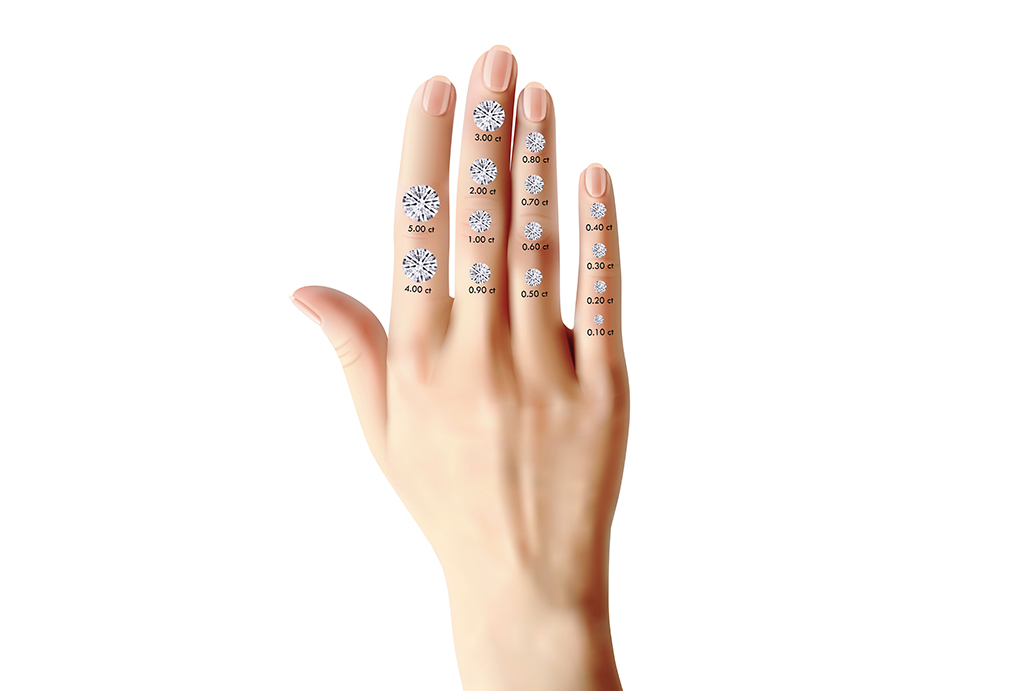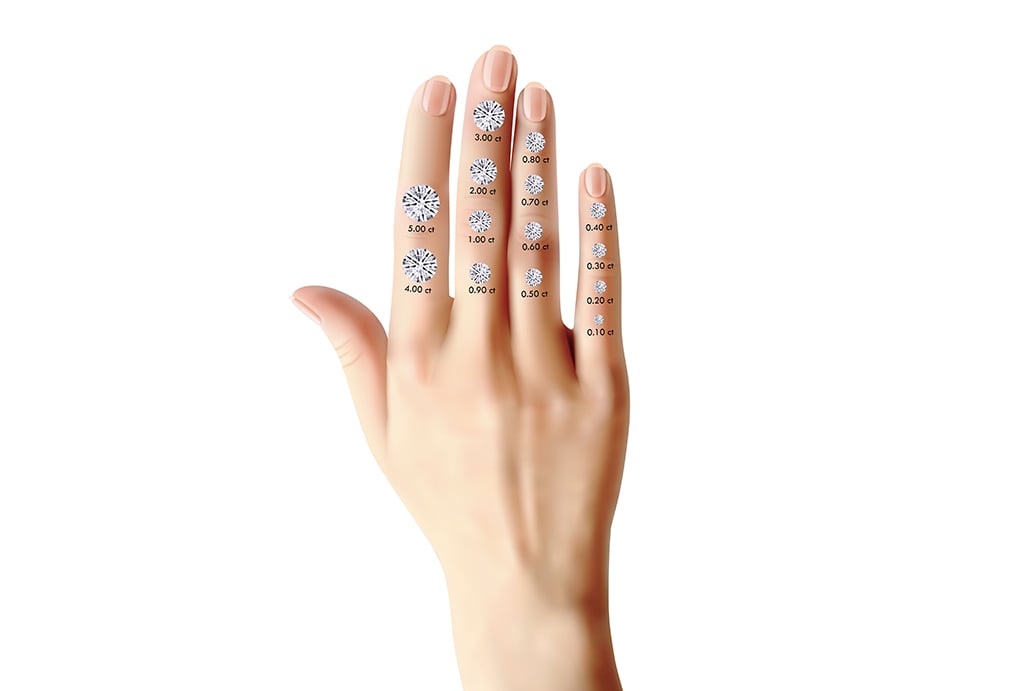DIAMOND CARAT
Diamond Carat is the term used to determine the weight of a diamond.
- One Carat = 0.20 grams or 200 milligrams
- Carat is also often referred to as 'points' where 1 point equals 0.01 carat.
So a 0.50 carat diamond would be referred to as a 50 pointer - Carat weight is abbreviated to ‘ct’
Carat is a measurement of weight, it should be noted it is not a measurement of size. However, carat is usually relative to size so the higher the carat the larger the stone.
This does not mean though that every diamond of same carat will be exactly the same size. For example, two 0.50 carat stones can be slightly different sizes.
The cut and shape proportions of a diamond can affect the size of one diamond compared to another. We can always provide some approximate or average measurements for every shape diamond in every carat size.
Use our interactive diamond size guide to get a better view on how different diamond shapes and weights will look. You can also view more information on each diamond with the menu button on the left.
Carat is not to be confused with karat. Karat is the value used for the purity of gold, for example 9 karat yellow gold.
Usually, it takes around 250 tons of rock mining to create one, 1 carat diamond. This is why diamonds are rare and that rarity is linked to price also. The rarer a diamond is, the more expensive it will be.
It is a common misconception that as carat doubles so does the size, for example that 0.80 carat is double the size of 0.40 carat and that 1 carat is double the size of 0.50 carat.
1 carat is double the weight of 0.50 carat but it is not double the size. In fact, there is only around 1.5mm between the two sizes on average.


Diamond Carat and Shape
The shape and cut of a diamond or gemstone plays a part in determining how large a stone is, or appears.
For example, an elongated shape, such as an Oval may appear larger than a rounded shape like that of a Cushion even if the two stones are the same carat weight. This is because it covers more of the finger.
Opting for elongated shapes like that of Oval, Marquise and Emerald stones may be a good idea if you are looking to utilise a diamond carat. They are also extremely popular for people with longer, more slender fingers as they pair with that really nicely too.
- When choosing diamond carat, don’t forget to consider the ring size too!
- A 1 carat diamond is going to look a lot larger on a size J finger than on a size Q finger.
- Factors like the wearer, and proportionally how that is going to look need to be considered also.
- Equally, does the wearer like jewellery that stands out, or would they prefer a more understated look?
Diamond Carat and Price
Diamond carat has the largest effect on price and there can be significant price difference between carat sizes.
In general, doubling the size of a diamond can often cost three to four, sometimes even six, times more. Diamond prices increased exponentially not in a linear way.
If specifications like clarity and colour are equal, a one carat diamond will cost more than a 0.97 ct diamond or a 0.91 ct diamond. However, if the specifications are not equal, it is possible that a one carat diamond will cost less than a 0.91 ct diamond for example.
It is important to consider whether size is most important for yourself, or quality, or if you would like a happy medium of both. For example a lot of people do just want to go for size and go for 1 or 1.20 carat. They are then happy to go with I1 and H selections as they do not mind the visible inclusions and a slight hint of yellow because they are getting the size they desire. Other people prefer a happy medium across the board and opt for selections like that of 0.50 ct, VS2, F and Very Good meaning the diamond is still a really good size and of excellent quality. This is why decisions vary from person to person and there is no right or wrong answer.
Lab Grown Diamonds, in general, enable people to get better all round selections for the 4 C’s as they command a lower price. You can read more on Lab Grown Diamonds here.
If you are not wanting to budge on quality but your jewellery piece is falling a little over budget, carat is a good option to move on. It has the most impact on price but visually, it is very hard to tell the difference between stones that vary around 5-10% in weight.
You can often save money by choosing a diamond that is around 0.10 carat less than the popular sizes. Certain diamond sizes, like that of 0.50, 1 and 2 carat, are highly sought after. A 0.90 carat and a 1 carat round diamond have around 0.25mm between them. They’ll appear almost identical in size but won’t carry the same price tag. The difference is barely distinguishable side by side and even less so, in a ring, on the hand.
How Carat is displayed
You should always pay attention to the way carat is displayed. For solitaire rings for example there is only one diamond in the ring so the carat shown and that you select is for that diamond only.
Side Stone rings are a derivative of this and are named online as ‘Solitaire with Side Stones’, so they are displayed in the same way. You are choosing the weight for the solitaire and then we add on the weight for the side stones. For all side stones rings the side stone carat is separate and can be found in the product description.
For Halo and Three Stone rings, as well as some other designs like a pair of earrings, it is the diamond total that is displayed or T.C.W (total carat weight). If you are unsure of how a piece of jewellery is shown please don’t hesitate to get in touch. We will be more than happy to confirm and to provide any breakdowns required if it is the total carat you are looking at.
Final things to note...
Certain settings can make a diamond look larger, for example Halo rings.
The contrast from the centre diamond to the smaller diamonds in the Halo can skew perspective and make the centre stone appear greater in size. Sometimes, when there is a minimal gap between the centre stone and the smaller stones in the halo and they are of matching selections, it can look just like one stone altogether!
Band width can affect the look of a diamonds carat also. A thinner, 1.8mm band will make the diamond look larger than a 3mm band for example.
A taper on the rings band can also affect how a diamond and its carat are seen. A taper, which is where the band gets thinner as it leads up to the diamond, can give the illusion that the stone is larger, compared to a band that remains the same width all the way around.
Carat tends to have the most impact visually on a diamond of the 4 C’s.
It does always come down to what you prefer. Would you prefer to have a larger carat and compromise on other selections or go for the opposite of this?
Most people do chose to select carat first, and then see what other selections fit into their budget. But there is no right or wrong way. Some people want their quality guaranteed first and then see what carat can work for them.
To stay within budget, as you increase carat, you may need to decrease your other selections. Equally, if you increase clarity and colour for example, you may need to move the carat lower a little.
